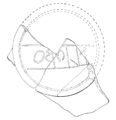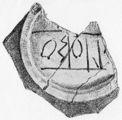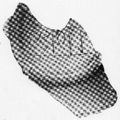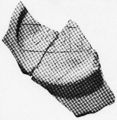CO·6
| Inscription | |
|---|---|
| Reading in transliteration: | p̣lioiso |
| Reading in original script: | |
|
| |
| Object: | CO·6 Rondineto (bowl) |
| Position: | foot, outside |
| Frame: | |
| Direction of writing: | sinistroverse |
| Script: | North Italic script (Lepontic alphabet) |
| Letter height: | 2.5 cm0.984 in <br /> |
| Number of letters: | 7 |
| Number of words: | 1 |
| Number of lines: | 1 |
| Workmanship: | scratched into leather-hard clay |
| Condition: | complete, damaged |
|
| |
| Archaeological culture: | Golasecca III A [from object] |
| Date of inscription: | 5th–early 4th c. BC [from object] |
|
| |
| Type: | prob. mark of manufacturer |
| Language: | Celtic |
| Meaning: | 'of Plios' |
|
| |
| Alternative sigla: | Whatmough 1933 (PID): 289 Solinas 1995: 80 Motta 2000: 14 Morandi 2004: 153 |
|
| |
| Sources: | Morandi 2004: 625 |
Images
|
| ||||
Commentary
First published in Barelli 1878: 14/Garovaglio 1878.
Images in Barelli 1878/Garovaglio 1878: tav. III.12 (drawing [mirrored] = Tibiletti Bruno 1969b: 274, tav. II.2a [as original] and b [corrected]), Barelli 1878b: tav. XII.13 (drawing by Giovanni Bergamaschi = Tibiletti Bruno 1969b: 275, tav. III.2c), Pauli 1885: Taf. I.18 e (drawing from Poggi), Rhŷs 1914: pl. III (photo), Tibiletti Bruno 1969b: 275, tav. III.2d (photo), De Marinis 1986: 76 (photo), Gambari & Colonna 1988: 161, fig. 24 (drawing), Morandi 1999: 183 (drawing = in essence Morandi 2004: 628, fig. 20.153) and 203, tav. XVI.2 (photo = Morandi 2004: 799, tav. XXII.153), Stifter 2020: 5, fig. 2 (photo).
Inscribed across the foot of the bowl; the fracture which runs across the inscription does not impede the reading. The letters are written before firing, between two frame lines which were drawn first, and applied quickly by a practised hand with lines drawn from the top toward the bottom. Both omicrons are executed as two half-circles, and sigma as a wavy line of – as first noted by Morandi 1999: 183 f., no. 32 – at least five bars (the bottom-most one coinciding with the break); a sixth bar could theoretically have existed on top, where the letter is incomplete. Originally read ]lioiso (Poggi 1879: 311, no. 46, Pauli 1885: 9 f., no. 18 e, Giussani 1902: 45, Rhŷs 1913: 39, III.1.1e); the tip of a bar before lambda first detected by Rhŷs 1914: 8, 10–23, who also observed that no letters can have existed before that first one due to the size of the foot; though he knew that pi for the first letter was more plausible, he emended incorrectly to elioiso based on linguistic considerations. Correct plioiso (though given as incomplete in the beginning) by Whatmough PID: 101, no. 289. Interpreted as an optative form by Tibiletti Bruno 1969b: 175–179, no. 2 (also Tibiletti Bruno 1969, Tibiletti Bruno 1978: 146 f., Tibiletti Bruno 1990b: 107 f.); interpretation as a genitive in -oi̯so based on comparison with NO·1 in Gambari & Colonna 1988: 161, no. 4 (also Prosdocimi 1991: 152 f., Motta 2000: 208 f., no. 14).
Application before firing is usually taken to indicate a potter's signature (e.g. Lejeune 1990: 70, no. 15), confirmed by two more attestations before firing on ceramics from Rondineto (CO·15, CO·16); also one post-firing (CO·72), but from the same time and area. Cue the plioiso-discussion.
See also Barelli 1878b: 210, Oberziner 1883: 145, Campanile 1969.
Bibliography
| Barelli 1878 | Vincenzo Barelli, "Nuove scoperte in Rondineto, comune di Breccia dal luglio 1877 in poi", Rivista Archeologica della Provincia di Como 13 (1878), 1–27. |
|---|---|
| Barelli 1878b | Vincenzo Barelli, "IV. Rondineto", Notizie degli Scavi di Antichità (1878), 201–224. |
| Campanile 1969 | Enrico Campanile, "Su una Presunta Forma Ottativale Epicorica a Comum", Studi e Saggi Linguistici 9 (1969), 211-215. |
| De Marinis 1986 | Raffaele De Marinis, "Lingua e alfabeto", in: Various authors, Como fra Etruschi e Celti, Como: Società Archeologica Comense 1986. (Catalogo della mostra), 73–76. |





